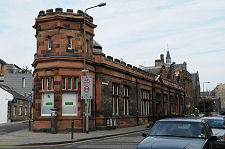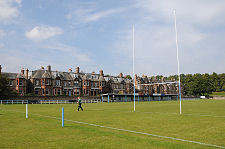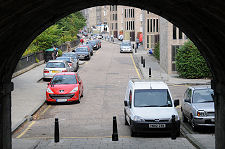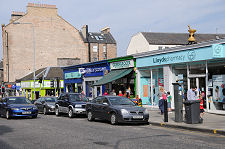 Stockbridge Seen Along Kerr Street |
Stockbridge is an area of Edinburgh on the north side of the city centre. Seen today it is effectively a continuation of the New Town which was developed on open land north of the existing city from the 1760s onwards. Look a little more closely, however, and it has a look and feel of its own, and a distinctive and vibrant character that is well worth seeing for yourself.
Stockbridge is well served by public transport from the centre of Edinburgh, though by far the best way to reach and explore it is on foot. The heart of the area is little more than half a mile north of the west end of Princes Street, and in many ways the best way to appreciate Stockbridge is having first walked through the rest of Edinburgh's fascinating New Town. One way we'd not recommend getting to Stockbridge is by car: parking tends to be expensive or restricted to residents.
The heart of Stockbridge is the Stock Bridge, where Deanhaugh Street crosses the Water of Leith. The Water of Leith travels through a deep gorge to the north-west of the city which restricted options for travel into the city from this side. It emerges from its gorge just to the south of Stockbridge and the site of today's bridge was for centuries the only point at which the Water of Leith could be crossed for some distance to the south, with the result that much of the traffic on this side of Edinburgh was funnelled over it.
Opinions differ as to the origin of the name. The "bridge" element is straightforward, but depending on the source you look at, "stock" could mean either "timber" or "cattle". Either way Stockbridge initially grew as a busy village surrounding a bridge on a main route to and from the city. With the growth of the New Town to the south-east from the 1760s traffic doubtless increased, and a stone bridge was built over the Water of Leith in 1786. Stockbridge remained separate from the ever approaching New Town, however, and was seen as a genteel country retreat convenient for the city.
The major reminder of this era is St Bernard's Well, a mineral water spring whose supposed health giving qualities were harness by the building of a well house in 1760. In 1789 work began on a much grander building, to a design of Alexander Nasmyth, in the form of an imposing Greek temple. St Bernard's Well continues to surprise walkers on the Water of Leith Walkway, but St Bernard's F.C., the professional football club which played at John Hope's Park in Stockbridge, only survived from 1878 to 1943.
Stockbridge began to develop into what you see today in 1813, when the painter Sir Henry Raeburn, a local landowner, began to develop the area with the help of the architect James Milne. Over time the developments in Stockbridge met and blended with the continuing outward growth of the New Town and today you would be hard pressed to say where one ends and the other begins. Some of Raeburn's work was not typical of the rest of the New Town: Ann Street, developed from 1814 and named after Raeburn's wife, is very unusual in having front gardens. A market was established in Stockbridge in 1825, a year after the nearby Edinburgh Academy.
Residential development continued into the 1860s and beyond and Stockbridge continued to grow throughout the century. A relatively late addition was the "Stockbridge Colonies", built in the years after 1860 by the Edinburgh Co-operative Building Company to provide low-cost housing for working people. They form eleven parallel streets on the north side of Stockbridge not far from the Botanic Gardens, which run down from Glenogle Road to the south bank of the Water of Leith. Today they are a highly desirable, and expensive, place to live.
The outcome of all this development was not always pleasant. One visitor in 1850 described the Water of Leith as "a great open ditch for the reception of every kind of filth, which accumulates in stagnant pools; until an occasional flood carries it off to the sea." Today the Water of Leith retains a surprisingly wilderness feel and can appear unkempt in places, but its days as an open sewer are long gone and the benefits of having what amounts to a linear park running through the centre of Stockbridge are tremendous. The walk for the half mile south-west to Dean Village can be highly recommended.
Today the centre of Stockbridge is dominated by two buildings. The first is the tower of Stockbridge Free Church. This was erected here in 1868 (having previously stood on Lothian Road until displaced by a railway). The rest of the church was demolished in 1980, leaving only the tower which has since been incorporated into more modern development. The second point of focus is the clock tower topping off what was originally a savings bank beside the bridge over the Water of Leith. This is now home to a Pizza Express.
 Raeburn Place |

|
|
|
Visitor InformationView Location on MapWhat3Words Location: ///swan.sports.vine |
 Deanhaugh Street |
 Water of Leith |
 Dean Terrace |
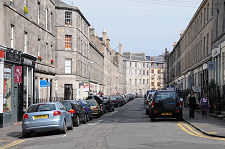 St Stephen Street |
 Pizza Express |
